UPDATE, April 2021: I’m sad to report that boxwood blight has been positively identified via plant samples I sent to the plant disease diagnostic lab in my garden. The five boxwoods in the first photo of this post are infected and will be removed. At this time I have not found signs of the fungus on other boxwoods in my yard and I certainly hope I won’t have to come back and update this post to say something different. Be vigilant, be careful where you buy your boxwoods from and look for blight-resistant varieties. –TIG
Because I watch a lot of British gardening television programming, I’ve been thinking about boxwood blight for a long time. The disease has been a problem across the pond for many years and recently has taken out beautiful old boxwood hedges in some of my favorite television gardens.
And I knew there was a good chance it would soon be my problem. We’ve been warned about it here for awhile and last July it was positively identified in a Wisconsin nursery. And that means it’s officially my concern now.
I don’t have miles of boxwood hedges in my garden, but it’s a plant I quite like and those I do have offer important structure in my garden. I would be sad to lose them and even sadder to have to eliminate it from my plant palette.
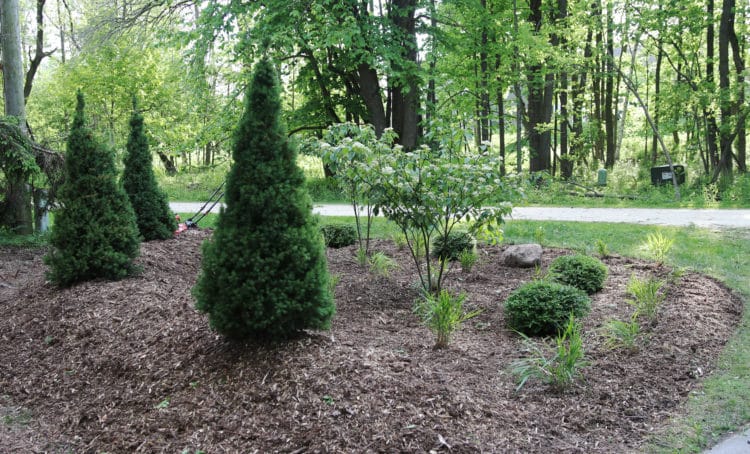
The key to facing any foe, be it in the garden or otherwise, is knowledge. Boxwood blight is a fungal disease that defoliates plants, often weakening young plants to the point of death and making older plants unattractive.
The fungus can be transferred from other plants (often before they show signs of infection), on tools or even in vehicles that transport plants. It can overwinter on plants or plant litter and can splash onto other plants during rains or irrigation. And it can also be found in Christmas wreaths that may come from areas with higher incidences of blight.
The first symptoms of blight are dark spots on leaves that develop into brown blotches. Sometimes white spores are visible on the underside of leaves. Blight is differentiated from other issues by black streaks on stems. Infected plants defoliate from the bottom up, which can kill young plants and leave mature plants so unattractive that you don’t want them around.
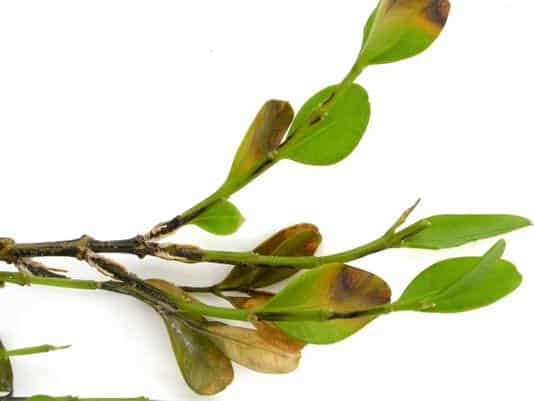
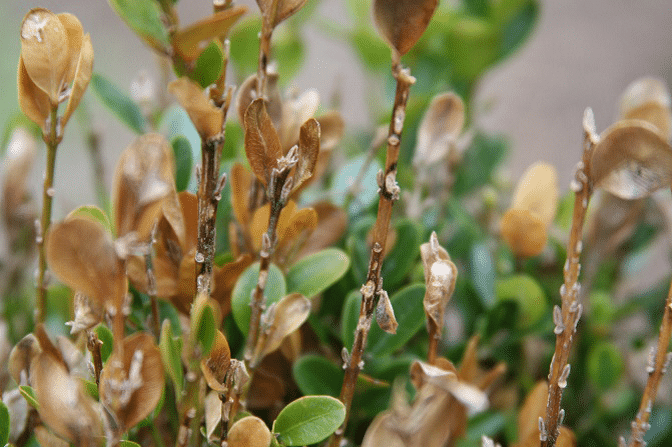
Obviously boxwoods are at risk, but some more than others. This fact sheet has a list of susceptibility based on cultivar, but some popular boxwood varieties, including Buxus microphylla ‘Winter Gem’, and ‘Green Gem’ are moderately resistant to blight, but others, including ‘Green Mound’ and ‘Green Mountain’ are moderately susceptible and ‘Glencoe’ (aka Chicagoland Green) is more susceptible.
Pachysandra and Sarcococca (sweet box) can also be affected by the fungus that causes boxwood blight.
Boxwood blight was first identified in the U.S. in 2011 and is now in at least 30 states—everything east of the Mississippi plus Kansas and West Coast states and three Canadian provinces.
The best way to avoid boxwood blight is to avoid bringing it into your garden. Some large gardens with established boxwood hedges do not bring new boxwood on the property, but if you’re not ready to put a moratorium on your boxwood buying, then you have to be really careful about where you shop.
Buy only from reputable nurseries with a boxwood blight compliance agreement. When you do buy boxwood, it’s advised that you keep the plants separated from existing boxwood in your garden for a month to keep an eye out for symptoms.
Clean up carefully when pruning boxwood, making sure to pick up leaf litter. Linda Vader from Potager Blog, who has beautiful boxwoods in her garden and gives excellent pruning tips on her Instagram account, uses a cheap vinyl shower curtain spread out under a plant to collect clippings. Keep composted clippings away from other plants and if there’s any worry about infection, but or throw clippings away rather than composting.
It’s also important to disinfect your pruning tools with a weak bleach solution before moving to other plants.
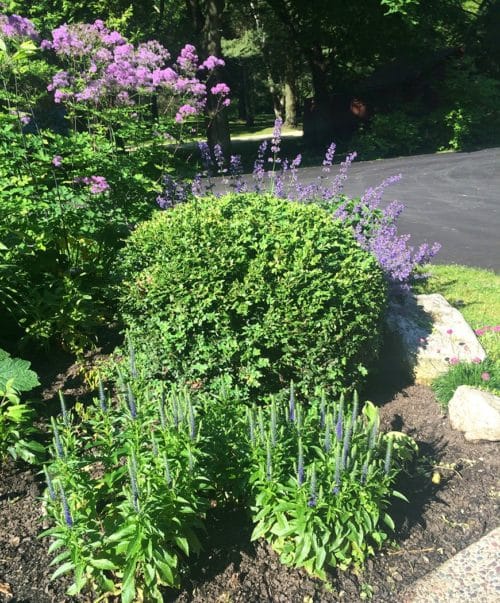
If all this identification information has just put you into a panic because it sounds like something you’ve seen in your garden, step off the ledge. There are some things you can do. First, make sure it really is boxwood blight by sending a sample to your university plant lab (do package it in a sealed bag though and DO NOT take a sample to a local nursery for identification).
Although you can’t cure the disease, you can treat boxwoods that aren’t showing signs of blight with a fungicide containing chlorothalonil. These include Ferti-lome’s Broad Spectrum Landscape and Garden Fungicide and Bonide’s Fung-onil. On affected plants, you can cut out diseased areas and treat with the fungicide, which may work.
And it’s just good gardening practice to avoid watering from above and keeping your plants healthy, because healthy plants are always less susceptible to disease than others.
If you have boxwood blight, most of this is probably old news to you. But if you’re like me, with some boxwoods in your garden but not a giant hedge that your garden would be lost without, you’re probably just trying to familiarize yourself with the disease and looking at smaller changes.
I’m not going to stop buying boxwood, but I’m changing the way I buy it. Smaller independent garden centers are already my preferred retailers but especially for boxwood I will only shop at garden centers (no big box stores) that have boxwood blight compliance agreements. If they don’t know what that is, I’m walking away. I know this probably mean I’ll pay even more, and boxwood is already pretty expensive.
I will also readily admit to being terrible about disinfecting my tools and cleaning up after pruning. That will change this year.
But I won’t treat with the boxwoods I have with fungicides unless I find evidence of blight somewhere.
Plant breeders are working hard to address the blight issue as well. NewGen boxwood was announced at plant shows in late 2018 and claims to be completely resistant to boxwood blight. It should be on the market in wide release in 2020.
Boxwood alternatives are also being developed. Proven Winners is offering two good boxwood alternatives this year: Strongbox and Gembox inkberry holly (Ilex glabra). These hollies have small leaves and take well to pruning, but unlike boxwood they can’t be pushed into part shade situations. And yews can be used in much the same way as boxwood.
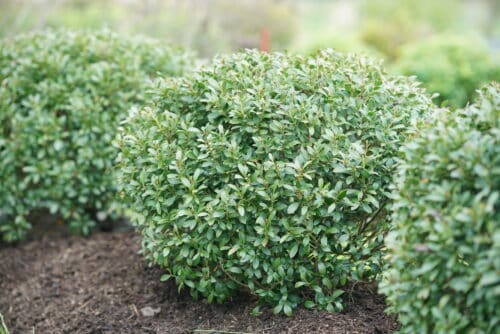
I’m approaching this as a garden threat that deserves some respectful prevention efforts, rather than outright hysteria (which I’m not opposed to when called for). Because I don’t want to think about a garden without boxwood.


14 Responses
Thanks for sharing information about Boxwood Blight. And thanks for your shout out for NewGen Boxwood! This issue is near and dear to us, and its great to see gardeners fighting the good fight. One quick note, NewGen™ Boxwood does NOT claim to be completely resistant to Boxwood Blight. We’ve spent the past 7 years testing for varietal tolerance and the varieties we have are listed as ‘more tolerant’ of boxwood blight than other varieties on the market. Research has not concluded that any variety of boxwood in entirely resistant. We hope through breeding and future research there may be varieties that are but at this time, the focus is on tolerance. If you have any questions, feel free to reach out or check out our website: http://www.newgenboxwood.com
Keep fighting the good fight! Thanks!
Thanks for the clarification. I’m excited about NewGen, and glad to see breeding working on solutions to a serious problem.
Excellent article, thank you. I live in Ottawa, Ontario and we’re seeing signs of blight throughout the city. Healthy gardening practices as mentioned in your article go a long way in preventing and containing the disease.
We are addicted to British gardening shows too! I hope you’ll share your favorites in a post–I feel like we could be missing one. We are redoing a bed in the front of our house and in lieu of boxwoods, I bought some compact Japanese holly (Ilex cremata “Compacta”) to try to replicate the look. Our next-door neighbor is establishing a boxwood hedge and I’m worried our homes are too nearby if something happens to his. The research for boxwood alternatives that I could keep very short took forever. I wish I’d known about the Ilex graba!
Thanks you for this very useful information.
I remember watching Monty Don rip out that gorgeous boxwood garden he had. I worry about this and the Hemlock disease since the are major elements in my garden. I can’t even count how many boxwoods I have. Luckily they are all pruned into balls and not a hedge so could be replaced with yews or something. I keep a spray bottle of lysol and a rag with my tools and I spray and wipe constantly when I am pruning woodies. It is probably the one really good garden habit I have!
You are so much better than I am! I need to become a more fastidious gardener, at least when it comes to cleaning up my tools. I hope Wisconsin won’t prove to be too hospitable for boxwood blight.
I’m worried about blight as well. Love the look and versatility of boxwood, and am still establishing gardens around the house we built 5 years ago. This past fall I took cuttings from the boxwoods I planted 4 years ago; I have about 3 dozen rooting, only 2 didn’t take. I’m sure it will take a few years for them to mature, but at least I won’t have to worry about bringing in disease. I’ll probably do this each fall or late summer for the next few years….
You are so smart to take cuttings. I wish I’d had that foresight. A few years ago I bought 18 very small ‘Glencoe’ boxwoods and I’ve been growing them out in pots. They are going in the ground this year, but I wish I hadn’t invested so heavily in one of the more susceptible varieties.
Too late for me. I had a row of topiary boxwoods in huge pots on my patio and they all succumbed. The boxwoods at the neighboring château also died; the gardens there are being redone and I wonder what is going to take their place.
I am so sorry to hear this. That’s tragic.
Good information. I would hate to lose the few boxwoods that I have.
Me too. They are important plants in a garden.